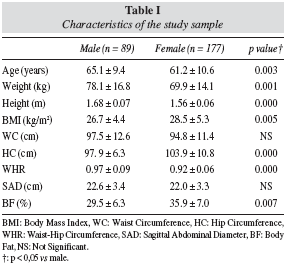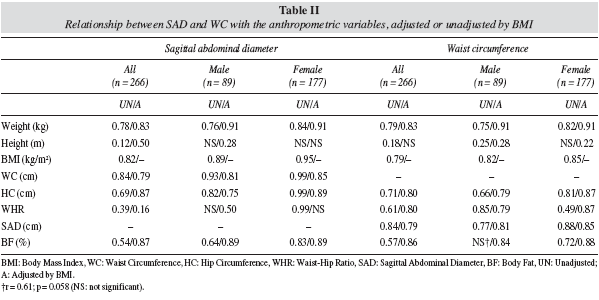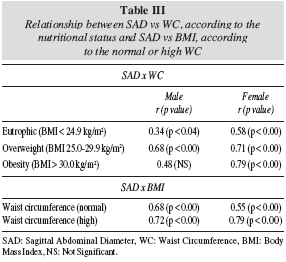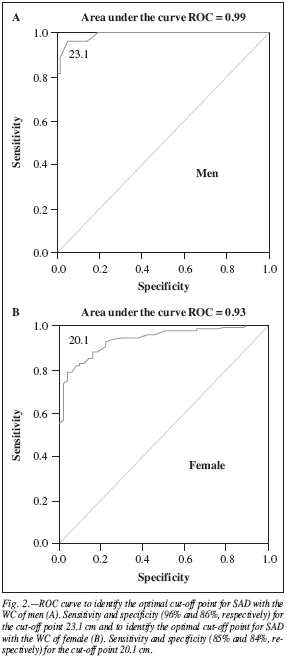Mi SciELO
Servicios Personalizados
Revista
Articulo
Indicadores
-
 Citado por SciELO
Citado por SciELO -
 Accesos
Accesos
Links relacionados
-
 Citado por Google
Citado por Google -
 Similares en
SciELO
Similares en
SciELO -
 Similares en Google
Similares en Google
Compartir
Nutrición Hospitalaria
versión On-line ISSN 1699-5198versión impresa ISSN 0212-1611
Nutr. Hosp. vol.25 no.4 Madrid jul./ago. 2010
Accuracy of sagittal abdominal diameter as predictor of abdominal fat among Brazilian adults: a comparation with waist circumference
Precisión de diámetro abdominal sagital como predictor de la grasa abdominal en brasileños adultos: una comparación con la circunferencia de la cintura
G. Duarte Pimentel1,2. K. C. Portero-McLellan1,3, N. Maestá1, J. E. Corrente4 and R. C. Burini1
1Center of Metabolism in Exercise and Nutrition (CeMENutri), Sao Paulo State University/UNESP. Department of Public Health. Botucatu/SP. Brazil.
2Federal University of Sao Paulo/UNIFESP. Department of Physiology. São Paulo/SP. Brazil.
3Pontificia Catholic University/PUC. Nutrition School. Campinas/SP-Brazil.
4Sao Paulo State University/UNESP. Department of Statistics. Botucatu/SP. Brazil.
The authors are supported by grants from Fundação de Amparo a Pesquisa do Estado de São Paulo (FAPESP, Brazil) and Conselho Nacional de Pesquisa e Desenvolvimento Tecnológico (CNPq, Brazil).
ABSTRACT
Aim: We aim was to compare the sagittal abdominal diameter (SAD) with waist circumference (WC) as a predictor of central obesity among adults and to identify the sensitivity and specificity of the best cut-off point for SAD.
Methods: A cross-sectional study of 266 Brazilians adults (euthrophic and overweight), aged 31-84 years old, of which 89 men and 177 women, was carried out. Anthropometric measurements such as SAD, weight, height, waist and hip circumferences, waist and hip ratio, body mass index, body fat percentage were performed. Receiver Operating Characteristics (ROC) curve was used to identify the sensitivity and specificity of the best cut off point for SAD as a predictor of central obesity. Statistical analysis were considered significant with a value of p < 0.05.
Results: The SAD measurement was positively correlated with WC for both genders, although stronger among overweight and obesity women (r = 0.71; p < 0.001 and r = 0.79; p < 0.001, respectively) than men. ROC curves identified the best cut-off points for SAD of 23.1 cm and 20.1 cm for men and women (96% and 85% sensitivity, 86% and 84% specificity, respectively).
Conclusion: SAD measurement may be used as an anthropometric tool to identify central obesity among women for presenting adequate sensitivity and specificity.
Key words: Visceral fat. Obesity. Sagital abdominal diameter. Waist circumference. Anthropometry.
RESUMEN
Objetivo: Nuestro objetivo es comparar el diámetro abdominal sagital (DAS) con la circunferencia de la cintura (CC) como predictor de la obesidad central entre los adultos y para determinar la sensibilidad y la especificidad de la mejor punto de corte para el DAS.
Métodos: Estudio transversal de 266 adultos brasileños (eutróficos y con sobrepeso), de entre 31-84 años de edad, de los cuales 89 hombres y 177 mujeres, se llevó a cabo. Las medidas antropométricas como la DAS, peso, talla, circunferencia de la cintura y cadera, relación cintura-cadera, índice de masa corporal, porcentaje de grasa corporal se llevaron a cabo. Receiver Operating Characteristics (ROC) curva se utilizó para determinar la sensibilidad y la especificidad del mejor punto de corte para el DAS como predictor de la obesidad central. El análisis estadístico se consideró significativo un valor de p < 0,05.
Resultados: La medición del DAS se correlacionó positivamente con CC para ambos sexos, aunque más fuerte entre las mujeres con sobrepeso y obesidad (r = 0,71, p < 0,001, r = 0,79, p < 0,001, respectivamente) que los hombres. De curvas ROC identificado las mejores puntos de corte para el DAS de 23.1 cm y 20.1 cm para los hombres y mujeres (96% y el 85% de sensibilidad, 86% y el 84% de especificidad, respectivamente).
Conclusión: La medición DAS puede ser utilizada como una herramienta antropométrica para identificar la obesidad central entre las mujeres para la presentación de la sensibilidad y especificidad adecuadas.
Palabras clave: Grasa visceral. Obesidad. Diámetro abdominal sagital. Circunferencia de la cintura. Antropometría.
Introduction
Visceral obesity is associated with metabolic abnormalities that increase risk of cardiovascular diseases1. Computed tomography and magnetic resonance imaging are gold standard technique, provide methods to estimate the visceral obesity, however are expensive and little used in clinical practice.2-3
Several studies suggesting that high waist circumference (WC) can identify individuals susceptible to insulin resistance and hypertension.4-5 However, the reliability of this measure in people with visceral obesity has been questioned6 by these individuals appear "tummy apron". Thus, sagittal abdominal diameter (SAD) was proposed as alternative for evaluate the body fat distribution,7 specifically intra-abdominal.8-9 SAD is a measure simple anthropometric, because it has show better correlation with insulin resistance than body mass index (BMI), WC, and waist-hip circumference (WHR).10
The identification of the cut-off point of SAD measurement for the determination of visceral fat has been few documented by studies.9,11-12 In the Brazil, only a study determined the cut-off points for the SAD by using the Receiver Operating Characteristics (ROC) curves with good sensitivity and specificity.9 In this like, ROC curves has been extensively utilized in studies of health and medicine area to examine the quality of the method. In other words, it is good quality when the ROC curve to get near to 1.00.13-15
Whereas most metabolic processes are mediated by the visceral fat deposition and that the evaluation of the SAD is very important to quantify the prediction of the risk factors of morbidity and mortality. Based on this, the present work aims to compare the SAD with WC as a predictor of central obesity among Brazilian adults and to identify the sensitivity and specificity of the best cut-off point for SAD.
Methods
Subjects and methods
Descriptive and cross-sectional study was conducted from February 2007 to April 2008 in patients screened clinically for lifestyle change program (LSCP) "Mexa-se Pro-Saúde". Were evaluated 266 patients (177 female and 89 male) with mean age 62.5 ± 10.3 yrs and BMI 28.0 ± 5.0 kg/m2. All the participants signed the free prior informed consent designed according to the no 196/96 on "Research involving human beings, from the Health Board of the Ministry of Health" approved (no 170/2005) by the Ethics Committee of Sao Paulo State University (UNESP, Brazil).
Body composition
In the assessment of body composition were performed, body weight, height, WC, hip circumference, WHR, and SAD. All the measurements were checked by trained nutritionists. Body weight and height were taken followed by BMI calculation and classified according to criteria established by the literature.16-17 Measuring of body weight was done in platform anthropometric scales (Filizola®) and measuring of body height was done by a portable estadiometer (SECA®), according to the norms described by Heyward & Stolarczyk.16
WC was measured between the last rib and iliac crests18 and hip-circumference (HC) at the largest circumference on trocanters,16 after the two measures was calculate the WHR, and for all measurements was used inelastic tape (TBW® Importadora Ltda).
The body fat percentage (%BF) was calculated from the resistance value (ohm) informed by BIA (Biodynamics® 450 model) and subsequent application in the equations recommended by the literature.19 For classification of BF% were utilized as normal values from 15 to 25% (men) and 20 to 35% (women).20 In order to reduce possible changes in water status, the study participants were demanded to follow these recommendations: avoid drinking alcoholic beverages as well as caffeine for 24 hours before the test, food fasting for 4 hours before the test, avoid intense exercising for at least 12 hours before the test, and let know about the use of medicine based on diuretics (in this case, the participants were not submitted to the test). The mensuration occurred with individuals in supine position, wearing only shorts and no metal accessories, away from any element that could cause electric current leakage, thus not interfering with the measurement of electric voltage. The electrodes were put at the back of the right hand and right foot, with the red and black terminals in the proximal and distal positions, respectively.16
The SAD was measured with a portable, sliding beam, abdominal caliper (Holtain, Ltd.; Dyfed, Wales, UK). The caliper's upper arm was brought down to just above an abdominal mark made midway between the iliac crests, a location that approximates to the L4-L5 interspace. The subject was asked to inhale and exhale gently, and the arm of the caliper was brought down to touch the abdominal mark without compression (fig. 1).
Statistical analysis
Data are presented as means and standard deviations. Within each sex group, normality of the distribution was tested for all the variables studied using the Kolmogorov-Smirnov test. We used the multiple regression and partial correlation unadjusted and adjusted for BMI between SAD and other anthropometric variables (age and demographics). Comparisons of age and all anthropometric variables between genders were performed using unpaired Student's t-test (specific for two independent samples).
Using the diagnosis of the WC to detect change or not adiposity, was made a ROC curves13,15 taking account of the diagnosis with values of the SAD, thereby the obtaining the cut-off point of SAD was obtained with higher sensitivity and specificity produced to detect the alteration in the SAD from the WC, where adopted for men (WC < 102 cm) and for women (WC < 88 cm), in other words, high sensitivity corresponds to high negative predictive value and is the ideal property of a "rule-out" test and high specificity corresponds to high positive predictive value and is the ideal property of a "rule-in" test. Thus, SAD values were estimated for both men and women and the cutoff point that produced the best combination of sensitivity and specificity was selected as the most appropriate value of the SAD in predicting visceral adiposity (WC < 88 cm for men) and (WC < 102 cm for women).
All statistical analyses and ROC curves were performed by using SPSS for WINDOWS (version 12.0; SPSS Inc, Chicago, IL). P < 0.05 was considered as statistically significant.
Results
The general characteristics of the subjects studied are shown in table I. The measurements of WC and SAD did not differ between the genders although women had higher BMI (p = 0.005), WHR (p < 0.001) and %BF (p = 0.007) values.
In table II, it is possible to observe that the anthropometric measurements as well as body composition were positively correlated to the ones of SAD and WC for both men and women. SAD had a strong correlation to WC (r = 0.84) and WHR (r = 0.39). After the BMI adjustment, the correlation of SAD with the variables weight (r = 0.83), height (r = 0.50), HC (r = 0.87) and %BF (0.87) were stronger.
This study showed that for both sexes the eutrophic and overweight subjects have a strong correlation of SAD with WC. Yet, when the obese subjects are evaluated, only women have some correlation between SAD and WC measurements (r = 0.79; p < 0.01). When there is a subsection of the sample in subjects with normal WC and high WC, both sexes show strong correlation between SAD and BMI (table III).
Figure 2 shows the cut-off points for SAD that correspond to altered WC (considering risks when WC>102 cm for men and > 88 cm for women), that is, 23.1 for men and 20.1 for women. In addition, such figure also shows the respective values of SAD sensitivity and specificity, which were 96% and 86% for men, and 85% and 84% for women, respectively.
Discussion
This study is the second one carried out in Brazil which determines the cut-off points of SAD through the ROC curve as a discriminator of visceral adiposity in both men and women. By analyzing the ROC curve it was possible to check that the SAD is an efficient method for predicting the accumulation of abdominal fat, and it showed to be better and more sensitive than the usual and simple WC measurement. Another benefit of measuring SAD would be that such measurement is made while the subject is lying down, which avoids that subcutaneous fat overlaps the abdominal fat, fact that can be observed in obese subjects who have a "tummy apron" (fig. 1).
A strong and significant positive correlation between the SAD measurements and the indicators of body adiposity (BMI, WC, HC, WHR and %BF) is observed in several studies on populations of different countries.3,9-10,21-28 Nevertheless, few studies determined the cut-off points for SAD using the ROC curve, which is considered the best method for this analysis.29 Among such studies, there is a Brazilian one carried out with healthy individuals of both sexes which compared the SAD to the computed tomography (19.3 cm and 20.5 cm were considered limit values in women and men with sensitivity of 85% and 83% and specificity of 77% and 82%, respectively)9. Our study identified the larger cut-off points for women and men (< 20.1 cm and < 23.1 cm, respectively) considering that most of the population studied was overweight and obese.
In the present study, the mean SAD value did not differ between men and women, but it is important to highlight that the correlation between SAD and WC was more strongly related among overweight and obese women. The correlation becomes weaker and less statistically significant when it evaluates obese men (table III). Thus, SAD for evaluating central adiposity should be used preferentially in women.
Like the present study, Zamboni et al. (1998)30 observed a stronger correlation among the variables which quantified the visceral adiposity after the BMI adjustment. Nevertheless, a research carried out in eutrophic and overweight elders found that the predictors of body-fat distribution are associated to cardiovascular risk factors regardless the BMI adjustment.7
The most relevant and important study for nutritional epidemiology is the American cohort one which evaluated 101,765 adults.24 In this study was observed that those subjects who had altered BMI were more likely to have altered SAD fin both sexes (Odds ratio-OR: 1.14 to 1.19 for men and OR: 1.13 to 1.22 for women). Preliminary research of our group has showed that subjects who had altered SAD were also 2.5 times likely to have altered WC. For those subjects who had altered BMI, the risk for SAD above normality was even higher OR: 7.99 times.31
Pouliot et al. (1994)32 carried out a study with men and women that demonstrated metabolic abnormalities (atherogenic profile) when the SAD values are above 25 cm or the WC is above 100 cm. Both WC and SAD are anthropometric predictors of the body fat distribution that better correlate to the predictors of cardiovascular risks in elders. Although, the studies shows that WC is considered a good body adiposity measure, recently the SAD is better than WC, because is highly associated to the insulin resistance, dyslipidemia, inflammation, hypertension, sudden death risk and erectile dysfunction.10,27,28,32-34 Therefore, in those subjects who have "tummy apron" (obesity) suggesting to use SAD and the WC for subjects euthrophic or overweight without obesity. In this like, Stevens et al.35 suggesting that measures of fat distribution such as SAD and WC are more highly correlated with cardiovascular disease risk factors and diabetes than BMI.
Including subjects with different ages ranging from adults to elders represents one of the limitations of the present study once it may be tendentious and biased concerning its results. However, as commented previously the determination of the SAD cut-off points for identifying central adiposity was done through an appropriate high-quality approach (ROC curve). Besides, the simultaneous analysis of sensitivity and specificity was an important anthropometric predictor for evaluating the population studied.
Conclusion
SAD is a good predictor of central adiposity in adults. In addition to this, it is significantly associated to other anthropometric measurements which evaluated body composition and body fat distribution. The cut-off points identified for SAD had high sensitivity and specificity, which shows that this method is appropriate for quantifying central adiposity, preferably in women.
References
1. Ntandou G, Delisle H, Agueh V, Fayomi B. Abdominal obesity explains the positive rural-urban gradient in the prevalence of the metabolic syndrome in Benin, West Africa. Nutr Res 2009; 29 (3):180-9. [ Links ]
2. Van der Kooy K, Seidell JC. Techniques for the measurement of visceral fat: a practical guide. Int J Obes Relat Metab Disord 1993; 17 (4): 187-96. [ Links ]
3. Kullberg J, Below VC, Lönn L, Lind L, Ahlström H, Johansson L. Practical approach for estimation of subcutaneous and visceral adipose tissue. Clin Physiol Funct Imaging 2007; 27: 148-53. [ Links ]
4. Grundy SM. Hypertriglyceridemia, insulin resistance, and the metabolic syndrome. Am J Cardiol 1999; 83: 25F-29F. [ Links ]
5. Hasselmann MH, Faerstein E, Werneck GL, Chor D, Lopes CS. Associação entre circunferência abdominal e hipertensão arterial em mulheres: Estudo Pró-Saúde. Cad Saúde Pública 2008; 24 (5): 1187-91. [ Links ]
6. Nordhamn K, Södergren E, Olsson E, Karlström B, Vessby B, Berglund L. Reliability of anthropometric measurements in overweight and lean subjects: consequences for correlations between anthropometric and other variables. Int J Obesity 2000; 24 (5): 652-7. [ Links ]
7. Turcato E, Bosello O, Di Francesco V, Harris TB, Zoico E, Bissoli L et al. Waist circumference and abdominal sagittal diameter as surrogates of body fat distribution in the elderly: their relation with cardiovascular risk factors. Int J Obesity 2000; 24 (8): 1005-10. [ Links ]
8. Hwu C-M, Hsiao C-F, Sheu WHH, Pei D, Tai T-Y, Quertermous T et al. Sagittal abdominal diameter is associated with insulin sensitivity in Chinese hypertensive patients and their siblings. J Hum Hypertension 2003; 17 (3): 193-8. [ Links ]
9. Sampaio LR, Simões EJ, Assis AMO, Ramos LR. Validity and reliability of the sagittal abdominal diameter as a predictor of visceral abdominal fat. Arq Bras Endocrinol Metab 2007; 51 (6): 980-6. [ Links ]
10. Risérus U, Arnlöv J, Brismar K, Zethelius B, Berglund L, Vessby B. Sagittal abdominal diameter is a strong anthropometric marker of insulin resistance and hyperproinsulinemia in obese men. Diabetes Care 2004; 27 (8): 2041-6. [ Links ]
11. Valsamakis G, Chetty R, Anwar A, Banerjee AK, Barnett A, Kumar S. Association of simple anthropometric measures of obesity with visceral fat and the metabolic syndrome in male Caucasian and Indo-Asian subjects. Diabet Med 2004; 21 (12): 1339-45. [ Links ]
12. Lemieux S, Prud'hormme D, Tremblay A, Bouchard C, Desprès JP. Anthropometry correlates to changes in visceral adipose tissue over 7 years in women. Int J Obes Relat Metab Disord 1996; 20 (7): 618-24. [ Links ]
13. Zhou XH, McClish DK, Obuchowski NA. Statistical methods in diagnostic medicine. John Wiley & Sons Inc, 2002. [ Links ]
14. Silva AC, Gattass M, Carvalho PCP. Diagnosis of Solitary Lung Nodule Using Texture and Geometry in Computerized Tomography Images: Preliminary Results. IEEE Latin America Transactions. 2004; 2 (2): 75-80. [ Links ]
15. Martínez EZ, Louzada-Neto F, Pereira BB. A curva ROC para testes diagnósticos. Cad Saúde Col 2003; 11 (1): 7-31. [ Links ]
16. Heyward VH, Stolarczyk LM. Avaliação da composição corporal aplicada. 1.ed. Barueri: São Paulo, 2000. [ Links ]
17. World Health Organization (WHO). Obesity: preventing and managing the global epidemic. Report of the WHO Consultation on Obesity. Geneva: World Health Organization; 1998. [ Links ]
18. IDBDTSM-I Diretriz Brasileira de Diagnóstico e Tratamento da Síndrome Metabólica. Arq Bras Cardiol 2005; 84 (Supl. 1): 1-28. [ Links ]
19. Segal KR, Van Loan M, Fitzgerald PI, Hodgdon JA, Van Itallie TB. Lean body mass estimation by bioeletrical impedance analysis: a four-site cross-validation study. Am J Clin Nutr 1988; 47 (1): 7-14. [ Links ]
20. Bray G. Na approach to the classification and evaluation of obesity. In: Björntorp P, Brodoff BN. Obesity. Philadelphia: J.B. Lippincott, 1992, pp. 294-308. [ Links ]
21. Petersson H, Daryani A, Risérus U. Sagittal abdominal diameter as a marker of inflammation and insulin resistance among immigrant women from the Middle East and native Swedish women: a cross-sectional study. Card Diabetol 2007; 6 (10): 1-7. [ Links ]
22. Öhrvall M, Berglund L, Vessby B. Sagittal abdominal diameter compared with other anthropometric measurements in relation to cardiovascular risk. Int J Obesity 2000; 24 (4): 497-501. [ Links ]
23. Kooy KVD, Leenen R, Seidell JC, Deurenberg P, Visser M. Abdominal diameters as indicators of visceral fat: comparison between magnetic resonance imaging and anthropometry. Br J Nutr 1993; 70 (1): 47-58. [ Links ]
24. Iribarren C, Darbinian JA, Lo JC, Fireman BH, Go AS. Value of the sagittal abdominal diameter in coronary heart disease risk assessment: Cohort study in a large, multiethnic population. Am J Epidemiol 2006; 164 (12): 1150-9. [ Links ]
25. Storti KL, Brach JS, FitzGerald SJ, Bunker CH, Kriska AM. Relationships among body composition measures in community-dwelling older women. Obesity 2006; 14 (2): 244-51. [ Links ]
26. Empana JP, Ducimetiere P, Charles MA, Jouven X. Sagittal abdominal diameter and risk of sudden death in asymptomatic middle-aged men: The Paris Prospective Study I. Circulation 2004; 110 (18): 2781-5. [ Links ]
27. Empana JP, Duciemetiere P, Balkau B, Jouven X. Contribution of the metabolic syndrome to sudden death risk in asymptomatic men: The Paris Prospective Study I. Eur Heart J 2007; 28 (9): 1149-54. [ Links ]
28. Frenhani PB, Pimentel GD, Portero-Mclellan KC, Burini RC. Sagittal abdominal diameter as a predictor of visceral abdominal fat, insulin resistance, dyslipidemia and inflammation in overweight Brazilian adults. Clin Nutr Suppl 2008, 3 (Supl. 1): 126. [ Links ]
29. Fletcher RH, Fletcher S, Wagner-RS EH. Epidemiologia Clínica: bases científicas da conduta médica. Porto Alegre: ARTMED, 1989, p. 312. [ Links ]
30. Zamboni M, Turcato E, Armellini F, Zivelonghi A, Santana H, Bergano-Andreis IA et al. Sagittal abdominal diameter as a practical predictor of visceral fat. Intern J Obesity 1998; 22 (7): 655-60. [ Links ]
31. Pimentel GD, Takahashi MM, Marsola FC, Manda RM, Rinaldi AEM, Maestá N, Burini RC. Influência demográfica na predição de gordura corporal de adultos pelo diâmetro abdominal sagital. VIII Jornada de Nutrição da UNESP de Botucatu, 2008. [In portuguese]. [ Links ]
32. Poulliot MC, Desprès JP, Lemieux S, Moorjani S, Bouchard C, Trembiay A et al. Waist circumference and sagittal abdominal diameter: best simple anthropometric indexes of abdominal visceral adipose tissue accumulation and related cardiovascular risk in men and women. Am J Cardiol 1994; 73 (7): 460-8. [ Links ]
33. Guzzaloni G, Minocci A, Marzullo P, Liuzzi A. Sagittal abdominal diameter is more predictive of cardiovascular risk than abdominal fat compartments in severe obesity. Int J Obes 2009; 33 (2): 233-8. [ Links ]
34. Riedner CE, Rhoden EL, Ribeiro EP, Fuchs SC. Central obesity is an independent predictor of erectile dysfunction in older men. J Urol 2006; 176 (4 Pt 1): 1519-23. [ Links ]
35. Stevens J, McClain JE, Truesdale KP. Selection of measures in epidemiologic studies of the consequences of obesity. Int J Obes 2008; 32 (Supl. 3): S60-6. [ Links ]
![]() Correspondence:
Correspondence:
Gustavo Duarte Pimentel.
Federal University of São Paulo (UNIFESP).
Department of Physiology.
CEP: 04023-062 São Paulo. Brazil.
E-mail: gupimentel@yahoo.com.br
Recibido: 9-IX-2009.
Aceptado: 16-XI-2009.



















